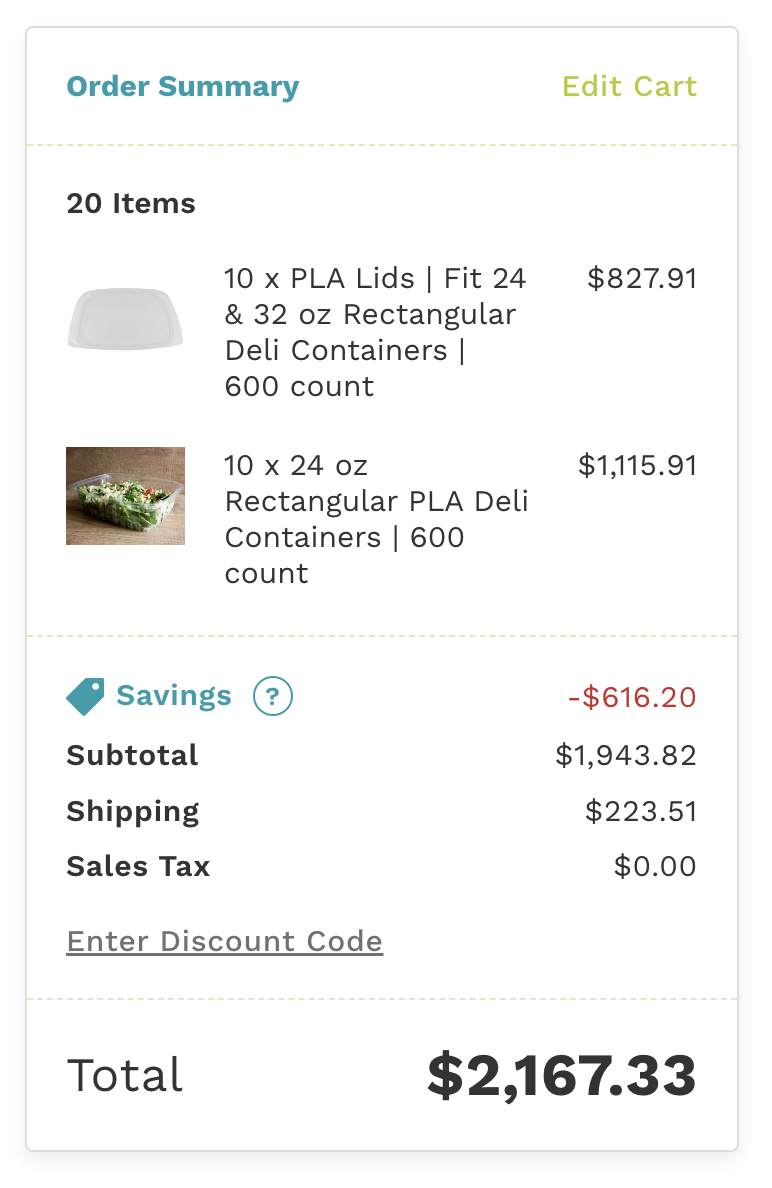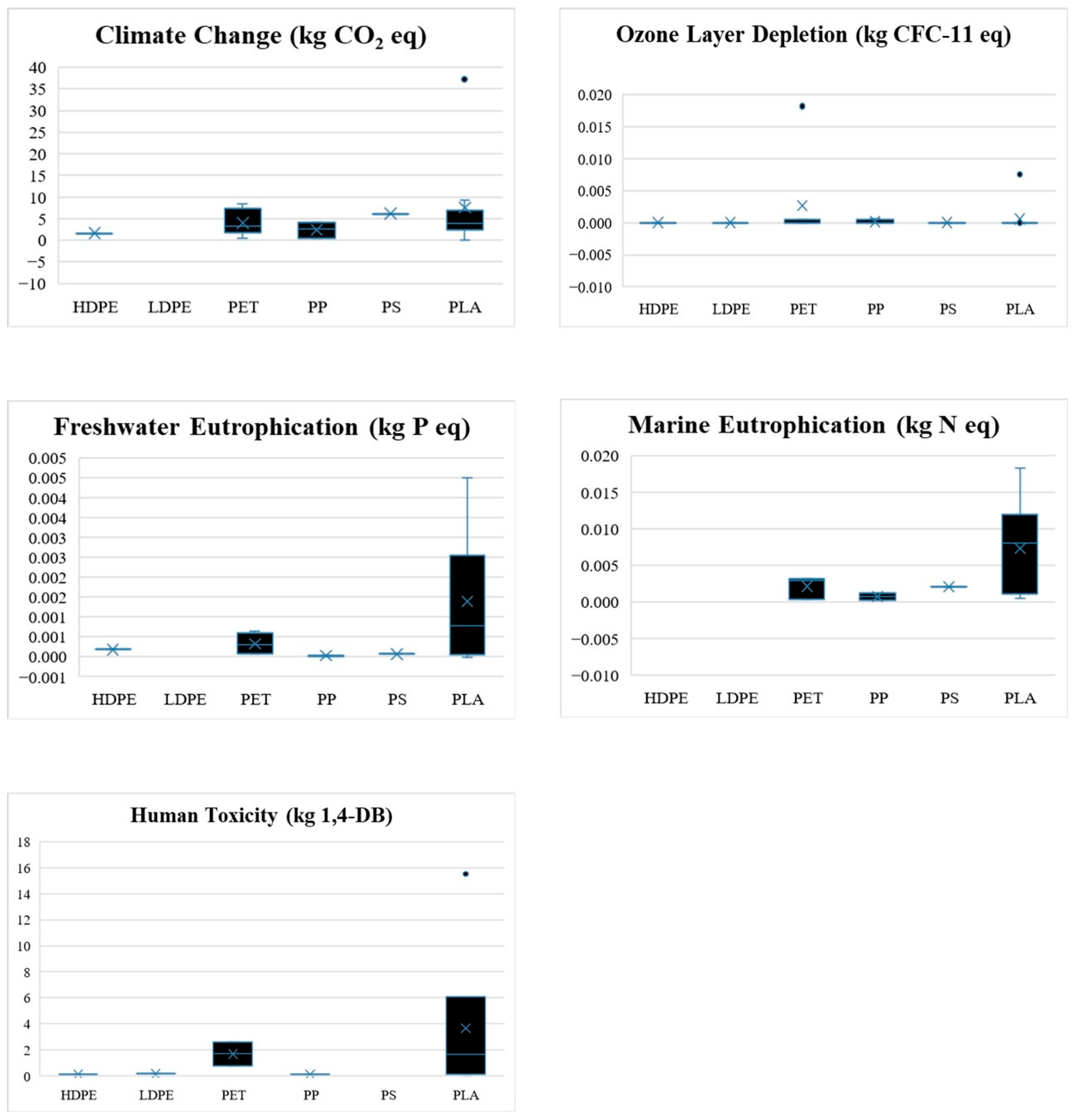Introduction
Companies have historically relied on petroleum-based packaging to store and transport their products. Plastic packaging is a great solution. It's strong, transparent, food-safe, and, most importantly, cheap. What if we could find the same benefits with an eco-friendly option, like packaging made from polylactic acid (PLA)? PLA is a newer type of packaging made using agricultural inputs, like corn, beetroot, or sugarcane bagasse. PLA can be made to be strong, transparent, food-safe, and affordable. So, why hasn’t the world seen widespread adoption of PLA? It turns out that PLA is still more expensive than PET, and it’s not always more environmentally friendly. We dug into the literature to see if PLA is better for our planet than PET/recycled PET (rPET).
PLA vs. PET: Big Picture
PLA, or polylactic acid, is a type of plastic made from plants like corn or sugarcane. As a result, it can decompose or degrade better than traditional plastics. Unfortunately, making PLA uses a lot of energy. Most of it comes from burning fossil fuels, which makes this solution a bit ironic. Let's not forget that the crops used to make PLA could instead be used for human consumption. Lastly, PLA will decompose, but it needs specific conditions. If your community doesn't offer a composting program, PLA packaging will likely end up in the landfill alongside PET products. PET, or polyethylene terephthalate, is the most common type of plastic in packaging. Thankfully, PET can be recycled. When recycled properly, rPET reduces the need to create new PET from virgin plastic.
Research Findings
- PLA packaging could be biodegradable and compostable if disposed of correctly. However, making PLA from agricultural feedstock does not align with the UN's (United Nation’s) SDGs (Sustainable Development Goals). Using farmland and freshwater to grow packaging crops competes with food for humans.
- Of the 100+ studies the authors reviewed, 44 considered corn the best source for PLA production. This supports the claim that PLA competes with farmland and food production. Corn as a PLA base is less eco-friendly than a crop byproduct, like sugarcane bagasse, a waste from sugarcane extraction.
- Researchers outline a handful of human health and environmental impact categories. PLA production had higher impacts on human toxicity, and freshwater and marine eutrophication. PET production had higher impacts on ozone layer depletion.
- The impact of packaging production depends heavily on the type of raw input, such as corn, beetroot, or sugarcane bagasse. The country of origin for that input dramatically affects the impact values. Inputs grown in South America or overseas are worse than those grown in the United States. Shipping the inputs or finished products vast distances increases overall fossil fuel use.
Cost Comparison
Let’s now compare the cost of PLA and PET packaging. We’ll use Good Start Packaging for the PLA packaging and Lacerta for the PET packaging. We’ll buy in bulk in both instances. We’ll compare similar, but not identical, styles of packaging.
Lacerta is a bulk manufacturer that sells by the pallet. A pallet quantity from Lacerta will be the benchmark. We can see from the screenshot below that my company, Piedmont Microgreens, paid $1,602.43 for 5,760 pieces of 24 oz. PET packaging. The cost per container is $0.28 ($1,602.43/5,760). Good Start Packaging (GSP) sells 24 oz. PLA packaging in cases of 600. Bases and lids are sold separately. It takes 9.6 of the GSP cases to reach the same quantity as a pallet from Lacerta. We’ll round up to 10 because GSP offers the greatest discount at that volume. We can see from the GSP screenshot below that the same order, except for the PLA component, will cost us $2,167.33. The cost per container is $0.36 ($2,167.33/6,000). The shipping cost is implicit in the Lacerta quote and explicit in the GSP quote. Compared to Lacerta’s PET packaging, GSP’s PLA packaging costs 28.6% more [(0.36-0.28)/0.28].
In an ideal world, we’d be able to compare different products from the same company, but this gets us close enough.


Conclusion
You’re paying more for PLA packaging with an ambiguous, if not worse, effect on the environment. The literature agrees, as much as possible, that PLA is not better for the environment than PET. Nor is the reverse true. When assessing multiple impact categories, PLA is worse in some and PET is worse in others. In other words, research shows that PET and PLA are similar. There are just trade-offs in their impact to various categories of human and environmental health. Pick your poison, literally. PLA has come a long way, but it’s by no means the panacea we want it to be. In my opinion, stick to PET/rPET for the time being. Eventually, smart people will continue to improve our packaging technology to a point where there is a clear winner.
Citations & Notable Research
Work Cited
- Abbate, E., Rovelli, D., Andreotti, M., Brondi, C., & Ballarino, A. (2022). Plastic Packaging Substitution in Industry: Variability of LCA Due to Manufacturing Countries. Procedia CIRP, 105. Science Direct.
- Ferrara, C., & De Feo, G. (2023). Comparative LCA of Two Different Packaging Systems for Extra-Virgin Olive Oil: Glass Bottle vs. 100% Recycled PET Bottles. Sustainability, 15(4): 3665. MDPI.
- Fonseca, A., Ramalho, E., Gouveia, A., Figueiredo, F., & Nunes, J. (2023). Life Cycle Assessment of PLA Products: A Systematic Literature Review. Sustainability, 15(16). MDPI.
- Ingrao, C., Gigli, M., & Siracusa, V. (2017). An Attributional LCA Application Experience to Highlight Environmental Hotspots in the Production of Foamy Polylactic Acid Trays for Fresh-Food Packaging Usage. Journal of Cleaner Production. Elsevier.
- Jayasekara, T., Surendra, Y.W., & Rathnayake, M. (2022). Polylactic Acid Pellets Production from Corn & Sugarcane Molasses: Process Simulation for Scaled-Up Processing & Comparative Life Cycle Analysis. Journal of Polymers & the Environment, 30. Springer Link.
- Madival, S., Auras, R., Singh, S.P., & Narayan, R. (2009). Assessment of the Environmental Profile of PLA, PET, & PS Clamshell Containers Using LCA Methodology. Journal of Cleaner Production, 17(13). Elsevier.
- Maga, D., Hiebel, M., & Aryan, V. (2019). A Comparative Life Cycle Assessment of Meat Trays Made of Various Packaging Materials. Sustainability, 11(19). MDPI.
- Rezvani Ghomi, E., Khosravi, F., Saedi Ardahaei, A., Dai, Y., Neisiany, R.E., Foroughi, F., Wu, M., Das, O., & Ramakrishna, S. (2021). The Life Cycle Assessment for Polylactic Acid (PLA) to Make It a Low-Carbon Material. Polymers, 13(11):1854. MDPI.
Select Articles
- Fonseca, A., Ramalho, E., Gouveia, A., Figueiredo, F., & Nunes, J. 2023. Life Cycle Assessment of PLA Products: A Systematic Literature Review. Sustainability 15(16). MDPI. https://www.mdpi.com/2071-1050/15/16/12470.
Abstract
"[Polylactic acid is a sustainable alternative to fossil fuel-based plastics because it's made from biodegradable materials. This paper aims to understand the environmental impacts of PLA compared to those of fossil fuel-based plastics. This paper is a systematic literature review of 81 LCA studies focused on PLA. We concluded that PLA has a greater impact on marine eutrophication, freshwater eutrophication, and human toxicity. These impacts are mainly due to the agricultural phase of growing PLA's raw materials. Polystyrene (PS) emits more greenhouse gases (GHGs). Polyethylene terephthalate (PET) has the most impact on ozone depletion. PLA is one solution to reduce fossil plastics. Yet, PLA inputs need to come from a source that doesn't compete with the feed and food sector.]”
Research Summary
- Packaging made from polylactic acid (PLA) could be biodegradable and compostable if disposed of correctly. However, making PLA from agricultural feedstock does not align with the UN's SDGs. Using farmland and freshwater to grow packaging crops competes with food production for humans.
- The paper compares the environmental impact of PLA, PP, PET, HDPE, LDPE, and PS. It does this by looking at dozens of other LCA reports. The authors standardized all units to 1 kg of each polymer.
- PLA - Polylactic Acid
- PP - Polypropylene
- PET - Polyethylene Terephthalate
- HDPE - High-density Polyethylene
- LDPE - Low-density Polyethylene
- PS - Polystyrene
- Of the 100+ studies the authors reviewed, 44 considered corn the best source for PLA production. This supports the claim that PLA competes with farmland and food production. Corn as a PLA base is less eco-friendly than a crop byproduct, like sugarcane bagasse, a waste from sugarcane extraction.
- The reviewed papers frequently mention the same human health and environmental impacts. These included ozone layer reduction, global warming, climate change, acidification, eutrophication of water, human toxicity, and land use. PLA had higher impacts on human toxicity, and freshwater and marine eutrophication. PET had higher impacts on ozone layer depletion.

- Ferrara, C. and De Feo, G. 2023. Comparative LCA of Two Different Packaging Systems for Extra-Virgin Olive Oil: Glass Bottle vs. 100% Recycled PET Bottles. Sustainability, 15(4): 3665. MDPI. https://www.mdpi.com/2071-1050/15/4/3665
Abstract
“[This study uses the Life Cycle Assessment (LCA) method. It assesses the sustainability of two packaging options for olive oil. The options are glass bottles and PET bottles made from 100% recycled PET. We compared six scenarios. They varied by the type of packaging system and the distribution phase. This included the distribution country and shipping logistics. The findings showed that the PET system is more sustainable than the glass system. This is true for all the impact categories considered. This is especially true for global warming, particulate formation, terrestrial acidification, and fossil fuel scarcity. For these, the recycled (R)-PET's life cycle impacts were less than 40% of the glass system's. In terms of global warming, the glass system created 790–1137 kg CO2 eq. In the same conditions, the R-PET system created 459–634 kg CO2 eq. This is mainly due to the high weight of the glass bottle, which affected the production and distribution phases. The mode of transport affected the impacts of the distribution phases. It showed that ship transport was more sustainable than truck transport.]
- Madival, S., Auras, R., Singh, S.P., & Narayan, R. 2009. Assessment of the Environmental Profile of PLA, PET, & PS Clamshell Containers Using LCA Methodology. Journal of Cleaner Production, 17(13). Elsevier. https://www.sciencedirect.com/science/article/pii/S0959652609000936.
Abstract
“[Prior papers assessing bio-based polymer resin and their end products show optimistic results. These papers compare PLA to petroleum-based products. They assess the products' environmental impacts and energy use. However, the impacts depend on the production system and the scope of the analysis. This paper reports an LCA of PLA and compares it to PET and PS. The assessment emphasizes different end-of-life scenarios. The paper considers all inputs in growing the PLA feedstock. These inputs are fertilizers, pesticides, herbicides, and corn seed. The scope for PET and PS includes the extraction of crude oil and the entire cracking process to create a final product. The impact categories include global warming, aquatic acidification, aquatic eutrophication, aquatic ecotoxicity, ozone depletion, non-renewable energy use, and land use. The geographical scope of the study reflects data from Europe, North America, and the Middle East. PET showed the highest overall values for all impact categories, mainly due to the higher weight of the containers. The main impacts to the environment were making the resins and transporting the resins and containers. This implies that the transport of the packaging is a big part of the packaging's environmental impact.]”
Related Articles
A Complete List of Microgreen Packaging Sources
Share this post: